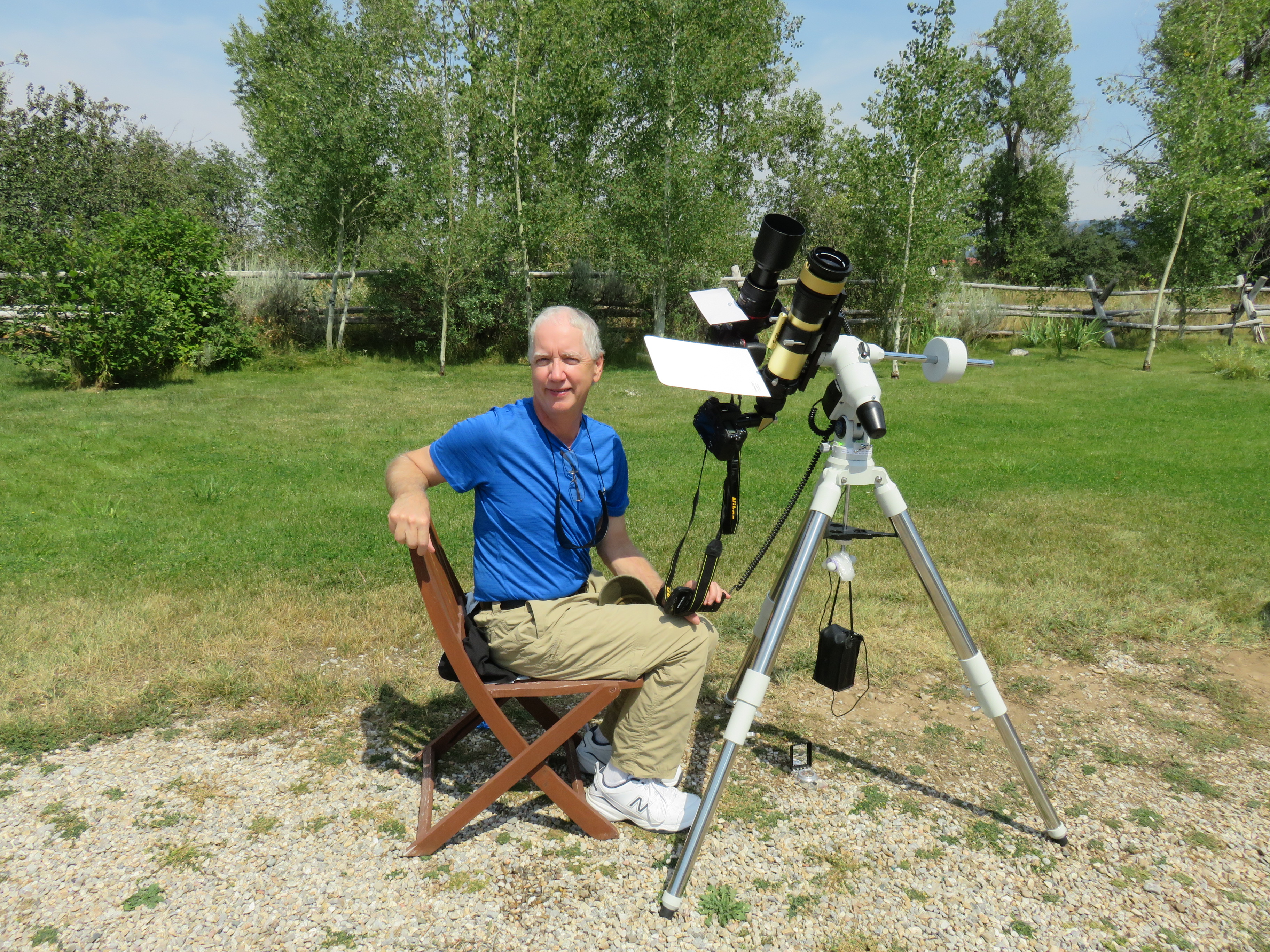Solar Eclipses and Daytime Solar Observing
This set of pages is dedicated to daylight solar observing. Many people new to astrophotography become frustrated with overcast or cloudy nights, but forget that daytime viewing, even with broken clouds, provides a great opportunity to observe the sun if you have the correct and safe solar filters. Typically filters added to the lenses of existing SLR Cameras is relatively low cost. (For instance, a typical lens eye-safe solar filter between 50-80 mm will run $60-80 on amazon or thousand oaks optical.) In addition, one of the most beautiful natural events is the solar eclipse. In this section, we'll cover some basics on solar eclipses, and provide detailed references to those seeking information on photographing the upcoming Great American Eclipse of April 8, 2024. Since Eclipses are on everyone's mind, let's start with this subject.
A Solar eclipse happens when three celestial events simultaneously occur. These are (1) The moon's "orbital nodes" intersect with, or are very close to intersecting with the ecliptic plane of our solar system. Since our moon's orbit is tilted 5.14 degrees from this ecliptic, we don't have solar and lunar eclipses every month. But when the moon's orbital node lines up with a New Moon (for solar eclipses) or full moon (for lunar eclipses) this offers the opportunity to view these events if you happen to be in the right place to view them. Since Lunar eclipses are covered in my Lunar Observing section, let's focus here on solar eclipses. First, to introduce the concept of a total eclipse, here is a video I created processed from ~260 individual images during the Great American Eclipse of August 17, 2017. After viewing the eclipse, I'll discuss a little more how I "got the shots".
Great American Total Solar Eclipse 17 August 2017
The equipment I used for photographing the 2017 total eclipse is shown in the picture below. There are actually two instruments being pointed at the sun, one is a single lens reflex (SLR) NIKON D7100 camera attached to a Nikon 80-400 mm zoom lens set to 400 mm. The lens also has a special solar filter screwed in to protect both the human eye and the camera sensor from the suns intense rays. The second instrument is a solar Hydrogen Alpha telescope, which I'll discuss latter. Both instruments are attached to a tracking device called a "declination/right ascension" tracking system. I have a separate discussion describing how this works, but for now, it is a device, once aligned, which will track the sun without continuously moving the camera manually, like you would have to with a standard tripod. Both of these optical instruments are certified eye safe.
Brian Next to his solar eclipse instruments
After seeing the total eclipse video above, the next 2 videos are of another type of solar eclipse called an "annular" eclipse. Annular eclipses happen, just like regular solar eclipses, when the moon is new and the orbital nodes line up. However, since the moon's orbit around the earth is elliptical, sometimes in earth's orbit the moon is too far away to completely cover the surface of the sun in an eclipse. At its maximum coverage, there is left an "annulus" or a "ring of fire" that's left uncovered. Annular eclipses happen about 58% of the time, total eclipses like the 2017 eclipse happen about 42% of the time. Amazingly, since the moon's shadow is so small, a total or annular eclipse is visible over only a tiny portio of the Earth's surface. On average, at any one place on earth, the odds of experiencing a total or annular eclipse is once in 360 years. So why did Albuquerque New Mexico get one on May 20, 2012 and October 14, 2023 after only 11 years? Remember I said "on average". (Note: Northern New Mexico gets another annular eclipse on November 15, 2077, so mark your calendar!)
Annular Solar Eclipse of May 20,2012 ALbuquerque, NM
Annular Solar Eclipse of 14 Oct 2023 Albuquerque NM - Again!
Next is a series of three videos of the recent Total Solar Eclipse of April 8, 2024.
The first was totality as photographed from Marble Falls Texas, about 50 miles northwest of Austin. The weather was far from ideal, with low and high clouds present throught the eclipse. At times, the sun's image was very good, but other times, the mages have a smokey appearance to them. The last 25 minutes of the eclipse, after totality, were entirely occluded with clouds.
The second video was filmed from Okemos, Michigan (42.71789° N, 84.41653° W ) which had a ~97% eclipse just outside of the zone of totality. The photographs were taken by my son Daniel Kent and I produced them into a video. The weather was supurb, although it obviously missed totalility by a whisker! (This video is in production, check back soon)
The Third video was filmed from Delaware, Ohio from (40.33352° N, 83.08270° W) which had a ~97% eclipse just outside of the zone of totality. The Photographs were taken by my Nephew Dr. Thomas Kent and I produced them into a video. The weather in Deleware, Ohio was also supurb, and made the zone of totality by about 30 miles on the southern edge of the eclipse shadow. (This video is in production, check back soon)
If you're interested in SAFELY photographing the sun or any upcoming solar eclipse, this presentation will give you all the details needed to SAFELY photograph this event. There alre also excellent websites to give you technical help in honing settings for your own camera, for instance (www.mreclipse.com) is Fred Espenak's excellent lunar and solar eclipse website with super detailed information on each and every eclipse.
Check out this presentation
The art and science of eclipse photography
More coming soon!
